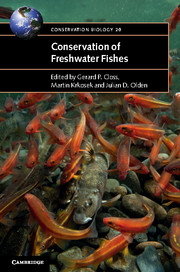Book contents
- Frontmatter
- Contents
- List of contributors
- Preface
- 1 Lost fishes, who is counting? The extent of the threat to freshwater fish biodiversity
- 2 Why are freshwater fish so threatened?
- 3 Climate change effects on freshwater fishes, conservation and management
- 4 Challenges and opportunities for fish conservation in dam-impacted waters
- 5 Chemical pollution
- 6 Multiple stressor effects on freshwater fish: a review and meta-analysis
- 7 Infectious disease and the conservation of freshwater fish
- 8 Non-indigenous fishes and their role in freshwater fish imperilment
- 9 Riparian management and the conservation of stream ecosystems and fishes
- 10 Fragmentation, connectivity and fish species persistence in freshwater ecosystems
- 11 Conservation of migratory fishes in freshwater ecosystems
- 12 Protecting apex predators
- 13 Artificial propagation of freshwater fishes: benefits and risks to recipient ecosystems from stocking, translocation and re-introduction
- 14 Freshwater conservation planning
- 15 Sustainable inland fisheries – perspectives from the recreational, commercial and subsistence sectors from around the globe
- 16 Understanding and conserving genetic diversity in a world dominated by alien introductions and native transfers: the case study of primary and peripheral freshwater fishes in southern Europe
- 17 Maintaining taxonomic skills; the decline of taxonomy – a threat to fish conservation
- 18 Synthesis – what is the future of freshwater fishes?
- Index
- References
4 - Challenges and opportunities for fish conservation in dam-impacted waters
Published online by Cambridge University Press: 05 December 2015
- Frontmatter
- Contents
- List of contributors
- Preface
- 1 Lost fishes, who is counting? The extent of the threat to freshwater fish biodiversity
- 2 Why are freshwater fish so threatened?
- 3 Climate change effects on freshwater fishes, conservation and management
- 4 Challenges and opportunities for fish conservation in dam-impacted waters
- 5 Chemical pollution
- 6 Multiple stressor effects on freshwater fish: a review and meta-analysis
- 7 Infectious disease and the conservation of freshwater fish
- 8 Non-indigenous fishes and their role in freshwater fish imperilment
- 9 Riparian management and the conservation of stream ecosystems and fishes
- 10 Fragmentation, connectivity and fish species persistence in freshwater ecosystems
- 11 Conservation of migratory fishes in freshwater ecosystems
- 12 Protecting apex predators
- 13 Artificial propagation of freshwater fishes: benefits and risks to recipient ecosystems from stocking, translocation and re-introduction
- 14 Freshwater conservation planning
- 15 Sustainable inland fisheries – perspectives from the recreational, commercial and subsistence sectors from around the globe
- 16 Understanding and conserving genetic diversity in a world dominated by alien introductions and native transfers: the case study of primary and peripheral freshwater fishes in southern Europe
- 17 Maintaining taxonomic skills; the decline of taxonomy – a threat to fish conservation
- 18 Synthesis – what is the future of freshwater fishes?
- Index
- References
Summary
DAMMED IF YOU DO, DAMNED IF YOU DON'T
Naturally flowing rivers are among the most dynamic ecosystems on Earth, with enormous spatial and temporal complexity. Streamflow defines the physical template of riverine ecosystems (Poff et al., 1997), provides longitudinal and lateral access to foraging, spawning and recruitment habitat (Junk et al., 1989), and acts as an evolutionary selective force and an ecological filter of various survival strategies employed by aquatic and riparian organisms (Townsend & Hildrew, 1994; Jackson et al., 2001; Lytle & Poff, 2004). At the same time, human society requires water for life. Over the millennia, humans have altered streamflow in riverine systems for myriad reasons including harnessing water for drinking, irrigation and recreation, and providing flood control and hydropower (Gleick, 2003). The freshwater footprint of humanity stamps the entire globe, with nearly half of major river systems affected by dams (Vörösmarty et al., 2010; Lehner et al., 2011). The future construction of dams, particularly in economically developing nations, is an inevitable consequence of human population growth and increasing freshwater and electricity needs in a changing climate (Palmer et al., 2008; McDonald et al., 2012).
Despite providing many societal benefits, river regulation by dams has also caused considerable ecological damage and the loss of important ecosystem services valued by society. Dams fragment rivers, creating strings of artificial lakes punctuated by barriers that are often impassable by fish, and they alter physical riverine habitat and water quality in both upstream and downstream directions (Nilsson et al., 2005; Reidy Liermann et al., 2012). In particular, dams are the primary driver of hydrologic change throughout the United States (Carlisle et al., 2011), resulting in reduced flow seasonality and variability and generally increasing short-term minimum flows while decreasing short-term maximum peaks (Poff et al., 2007). These changes alter the historical disturbance regime, rendering some biotic adaptations to these regimes obsolete while potentially favouring others. For example, reduced flow variability by dams has been associated with significant losses of native fish species (Meador & Carlisle, 2012) while concurrently creating new niche opportunities above and below dams that are often occupied by non-native fishes (e.g. Olden et al., 2006; Johnson et al., 2008).
- Type
- Chapter
- Information
- Conservation of Freshwater Fishes , pp. 107 - 148Publisher: Cambridge University PressPrint publication year: 2015
References
- 42
- Cited by



